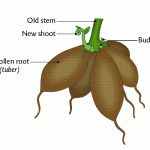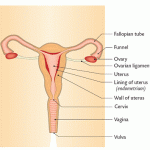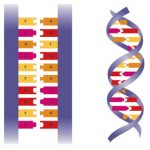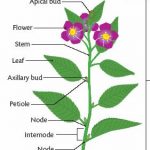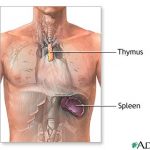Contents
- The Female Reproductive Organ: The Carpel
- The Male Reproductive Organ: The Stamen
- Petals, Corolla, Sepals, Calyx
- Formation of Sex Cells
- Development of the Embryo Sac
- Pollination
- Fertilisation
- Double Fertilisation
- Seed Formation
- The Embryo
- Monocots and Dicots
- Fruit Development
- Fruit and Seed Dispersal
- Dormancy
- Germination
- Events of Germination
The Female Reproductive Organ: The Carpel
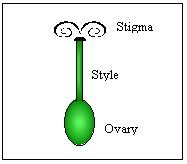
The female parts of a flower consist of an ovary, which contains one or more ovules, a style and the stigma. The ovary is at the base of the flower.
From the ovary, extends a tubular structure called the style and on the top of the style is a surface receptive to pollen called the stigma.
The stigma can take many different forms, most of them designed to help trap pollen. There are many variations on this basic structural theme.
After fertilization the ovule becomes the seed and the ovary becomes the fruit.
The Male Reproductive Organ: The Stamen
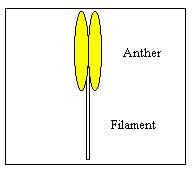
The male parts of a flower consist of one or more stamens. Each stamen is made up of paired anthers (sacs containing pollen) on a filament or stalk.
The anthers are the orange/yellow structures often seen in the centre of a flower.
Pollen from the anthers of one flower is transferred to the stigma of another usually either by wind, or by animals, especially insects.
Petals, Corolla, Sepals, Calyx
The reproductive structures in higher plants are contained within flowers. Flowers have more than one petal, and the flower petals are collectively called the corolla. A flower bud is protected by green leafy structures called sepals. Collectively, all of the sepals form the calyx.
The corolla or petals are often brightly coloured with markings attractive to insects. The flowers may also be scented. For instance, Honeysuckle has showy, attractive flowers which attract insects by day. However, in the dark, their colourful show is not much use, and their heady scent then helps to attract night-flying moths.
In insect-pollinated plants, there are also usually nectaries which secrete sugary nectar, located within the flower. These provide an incentive to insects to visit the flowers. In the search for nectar, the insects will often get pollen grains caught on their bodies. This may then brush off onto the stigma of the next flower visited and in this way the flowers are pollinated.
The receptacle is the place on the stem where floral organs originate and attach.
Formation of Sex Cells
The sex cells of the flowering plant are called gametes. There are both male and female gametes thus the flower undergoes sexual reproduction.
Pollen Formation: Development Of A Pollen Grain Within The Pollen Sac Of An Anther:
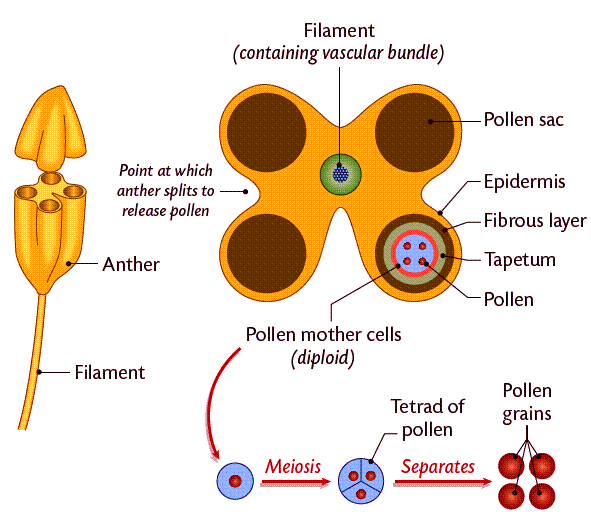
A cross section of the developing anther displays four chambers. These chambers are called pollen sacs (see upper illustration). Each pollen sac is filled with cells containing large nuclei. As the anther grows, each of these cells goes through two meiotic divisions, forming a tetrad. These cells are called microspores. Each one of these microspores eventually becomes a pollen grain. Each pollen sac is enclosed by a protective epidermis and a fibrous layer. Inside the fibrous layer is the tapetum. This is a food store and will provide energy for future cell divisions.
Each pollen grain is surrounded by a tough protective wall called an exine. This is a tough covering that allows the pollen grain to survive harsh conditions for long periods of time. The intine is another thin protective coating.
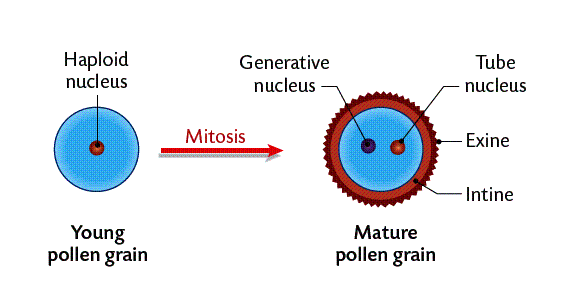
First, each nucleus divides by mitosis to become two nuclei. One is the tube nucleus. The other is a generative nucleus. The wall of the cell thickens to protect the developing pollen grain. As the anther ripens, the wall between the paired pollen sacs disappears. The pollen sacs burst open and the mature pollen grains are ready for dispersal.
Development of the Embryo Sac
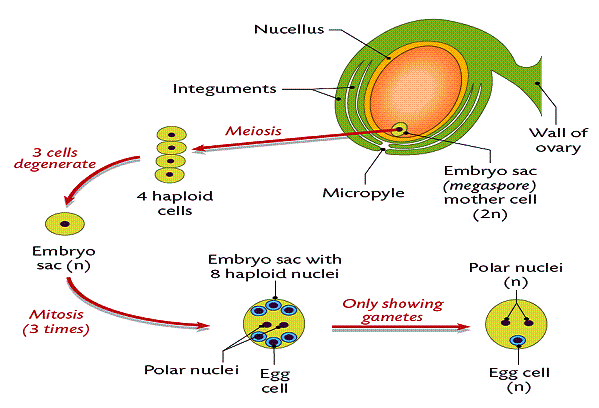
Each ovary contains one or more ovules. The green structure at the top of the diagram is the ovule. The integuments are the 2 walls of the ovule. There is a small opening in the walls called a micropyle. This is where the pollen tube will enter. (Will be discussed later.) The nucellus is cells that provide nutrition for the growth of the ovule. The embryo sac, also known as the megaspore, divides by meiosis to form 4 haploid cells. Three of these cells degenerate and one remains. Only one megaspore survives in each ovule. This becomes the embryo sac. The haploid nucleus of the surviving megaspore undergoes three mitotic divisions. Eight haploid nuclei are now present. Within the swollen megaspore cell, six haploid cells and two polar nuclei are formed. The entire structure is called the embryo sac. One of the cells near to the micropyle end of the ovule is the haploid female gamete (egg cell).
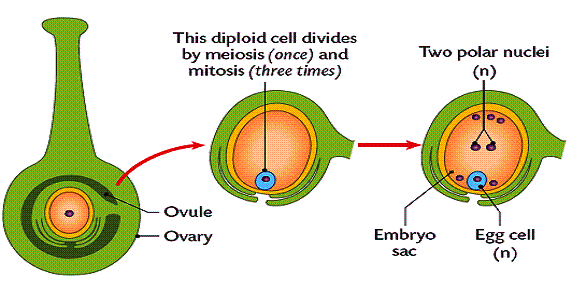
The Carpel With a Mature Embryo Sac will appear as shown below:
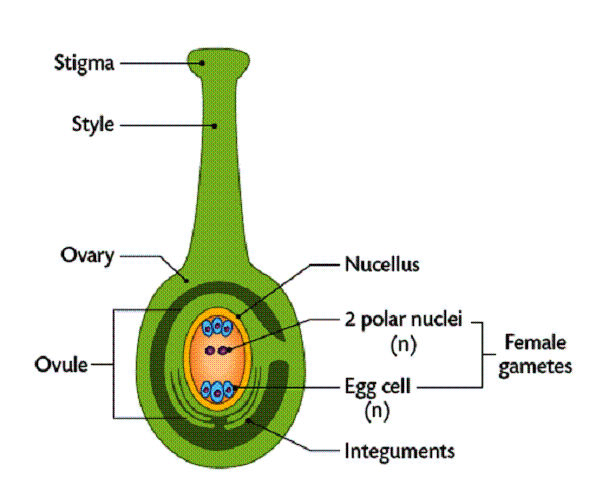
Pollination
Pollination is the transfer of pollen (male gamete) from the anther to a stigma. Cross-pollination: pollen is transferred to the stigma of another plant. Increases genetic variation, population more resistant to environmental change.
Self-pollination: pollen transferred to the stigma of the same flower or a flower of the same plant. Guarantees reproduction if pollinating agent is absent or not efficient.
Pollination can be accomplished by the wind or by animals. Insects are the most common animals that will pollinate a carpel.
The most sophisticated relationships between plants and insects are generally those involving bees. Bees collect pollen and nectar not only for themselves but also to feed their young. For this reason bees have developed a number of adaptations that make them particularly good pollen carriers. Bees have special hairs that are arranged to form pollen ‘baskets’ on their hindlegs and the underside of their abdomen. These adaptations allow them to gather and carry large volumes of pollen. Bees are ideal pollinators because they visit many flowers while carrying lots of pollen, before returning to their nest. So the chance that a bee will transfer the pollen between flowers of the same species is very high.
Many insects eat pollen. In the process of eating they become covered in it. Pollination happens when the pollen feeder transfers the pollen to the pollen receivers of the same plant, or another plant of the same species, as the insect looks for more pollen to eat.
Fertilisation
Fertilisation is the union of the male and female gametes to form a zygote. Since the male and female gametes are haploid (n) when the two unite the zygote is diploid (2n).
Fertilisation starts when a pollen grain lands on the stigma. The pollen grain then grain germinates forming a pollen tube. The tube nucleus controls the growth of the pollen tube. The pollen tube is an example of chemotropism since it is growing toward chemicals produced from the ovule. The generative nucleus travels down the pollen tube. It undergoes mitosis forming two haploid male gamete nuclei. The pollen tube enters the ovule by way of the micropyle. The two male gamete nuclei are released into the embryo sac. The tube nucleus disintegrates.
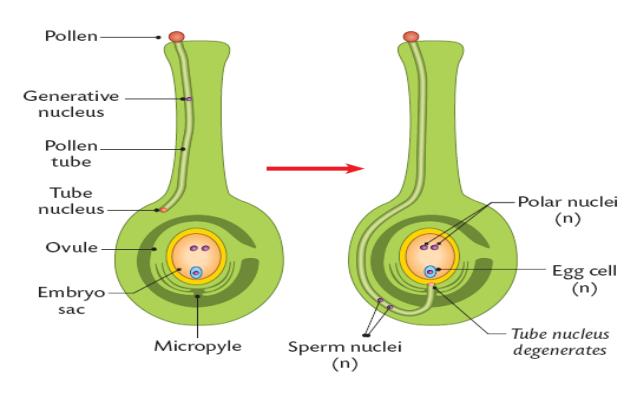
Double Fertilisation
Since there are 2 sperm nuclei that have reached the embryo sac both nuclei will fuse with female gametes. One sperm nuclei will fuse with the egg cell to form the zygote (2n) while the other sperm nucleus fuses with the 2 polar nuclei in the embryo sac to form an endosperm nucleus (3n).

Seed Formation
The fertilized becomes the seed. The integuments become the wall of the seed called the testa. The micropyle closes. The endosperm nucleus leads to the formation of triploid endosperm, a food tissue. The diploid zygote, by mitosis, develops into a plant embryo. The developing embryo draws nourishment from the endosperm. The embryo ceases development and goes dormant. The ovule becomes a seed, which contains a dormant plant embryo, food reserve, and the protective coat called the testa.
The Embryo
The embryo is made up of the radicle or future root and the plumule or future shoot. The endosperm cells divide many times and absorb the nucellus. This is the nutrition (mainly fats, oils and starch) for the embryo.
There are 2 types of seeds. Some are endospermic while others are non-endospermic. In endospermic seeds the food reserve is the endosperm, which is outside the plant embryo. Examples of this type of seed are maize and wheat. Non-endospermic seeds have food reserve within the cotyledon(s) of the plant embryo. This occurs in broad beans.

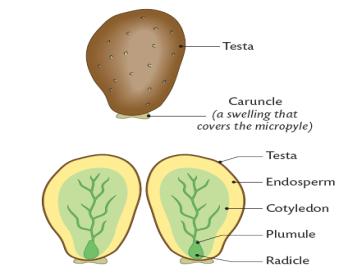
Monocots and Dicots
Monocots have one cotyledon in the seed while dicots have two cotyledons. The cotyledons are food reserves for the young plant after it germinates from the soil. It uses these food reserves until it is capable of making its own food. In monocots the food is absorbed from the endosperm while in dicots the food is stored in the cotyledons.
Monocot:

Dicot:
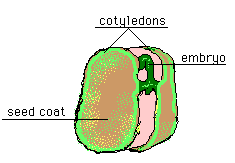
Fruit Development
The ovary becomes a fruit. The wall of the ovary becomes the wall of the fruit called the pericarp. The fruit protects the developing seeds and plays an important role in seed dispersal. This process is controlled by auxins produced by the seeds. Once the fruit forms the rest of the flower parts die and fall away.
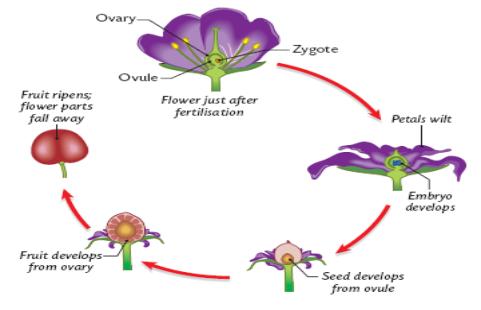
Fruit and Seed Dispersal
Seed dispersal is the scattering of offspring away from each other and from the parent plant. As a result of dispersal there is an improved chance of success by reducing competition and overcrowding. Dispersal also enables colonisation of new suitable habitats and thus, there is an increased chance of species survival.
Methods of Seed Dispersal:
Wind: The seeds of wind-dispersed plants are lightweight seeds. They have a high air resistance so they can be carried far away from the mother plant.
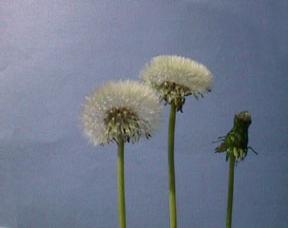
Water Dispersal:
Fruits which float such as those of the water lily and the coconut palm are carried by water. Coconuts can travel for thousands of kilometres across seas and oceans.
The original coconut palms on South Sea Islands grew from fruits, which were carried there from the mainland by ocean currents.
Animal Dispersal:
Some plants have juicy fruit that animals like to eat.
The animal eats the fruit but only the juicy part is digested.
The stones and pips pass through the animal’s digestive system and are excreted to form new plants. This can be far away from the parent plant. Blackberry, cherry and apple seeds are dispersed in this way.
Birds also like to eat fruit and they help to disperse seeds to other areas through their droppings.
Mistletoe has sticky fruits that are attractive to birds. The sticky seeds stick to the bird’s beak. They then rub their beaks clean on the bark of trees. The sticky seeds are left on the bark to grow into new mistletoe plants – mistletoe is a parasitic plant.
Squirrels collect nuts like acorns and bury them for winter food, but they often forget where they have buried them and these grow into new trees.
Some fruits like that of the burdock plant have seeds with hooks. These catch on the fur of animals and are carried away.
Self-Dispersal: Some plants have pods that explode when ripe and shoot out the seeds. Lupins, gorse and broom scatter their seeds in this way. Pea and bean plants also keep their seeds in a pod. When the seeds are ripe and the pod has dried, the pod bursts open and the peas and beans are scattered.
Dormancy
Dormancy is a period of inactivity. There is very little cellular activity and no growth. One or many of the following reasons bring about dormancy:
Auxins that inhibit growth- Growth Inhibitors
The testa is impermeable to water and oxygen- The testa will eventually break down and allow water and oxygen into the seed.
The testa may be too hard for the embryo to germinate.
An Auxin (Growth Regulator) may be absent until suitable environmental conditions develop.
Germination
The embryo will germinate from the seed if the proper environmental conditions are present. When this occurs the embryo resumes its growth.
In order for germination to occur the following conditions must be present:
Water must be present. This allows the seed to swell and enzymes to function.
Oxygen must be present in the soil.
The temperature must be suitable for the species of plant. Suitable temperatures are usually between 5-30 degrees Celsius depending on the species.
The dormancy period must be complete.
Some seeds need light and others need darkness.
Events of Germination
When germination begins the first thing that happens is water is absorbed by the seed through the micropyle and through the testa.
Enzymes in the soil now digest the foods stored in the seeds:
Oils become fatty acids and glycerol
Starch becomes glucose
Protein becomes amino acids
These foods now are absorbed by the embryo.
The glucose and amino acids make new structures such as cell walls and enzymes.
The fats and glucose are used in cellular respiration to produce energy.
The stored food of the seed is being used up as the embryo grows larger.
The radicle grows larger and breaks through the testa. It becomes the roots of the new plant.
The plumule grows larger and emerges above the ground.
Leaves form.
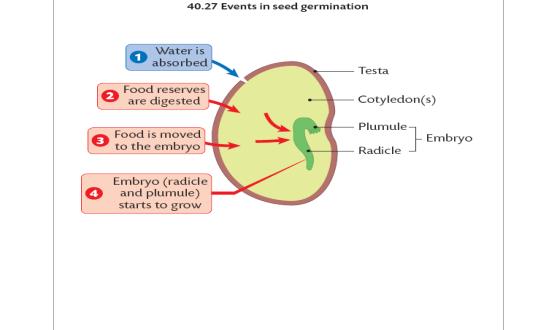
Germination occurs differently in different plants. In some plants the cotyledon remains underground while in other plants the cotyledon emerges above ground. The diagrams below show these 2 methods of germination.
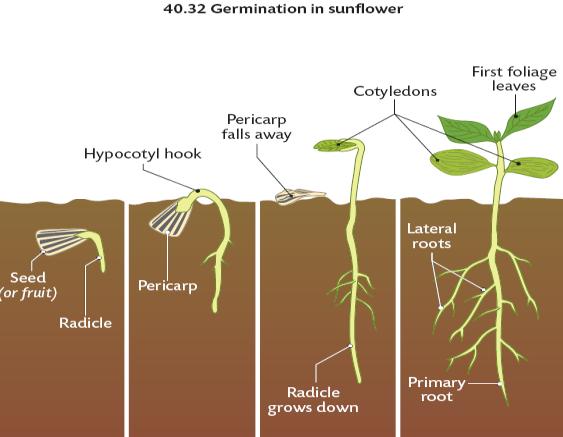
If you like flowers, check out the gardening tips at EcosystemGardening.com.
Are you a fan of the Premier League? Get free bets when signing up to William Hill with this exclusive promo code at https://redeembonuscode.co.uk/william-hill-promo-codes/. Find more online promo codes at RedeemBonusCode.co.uk!

